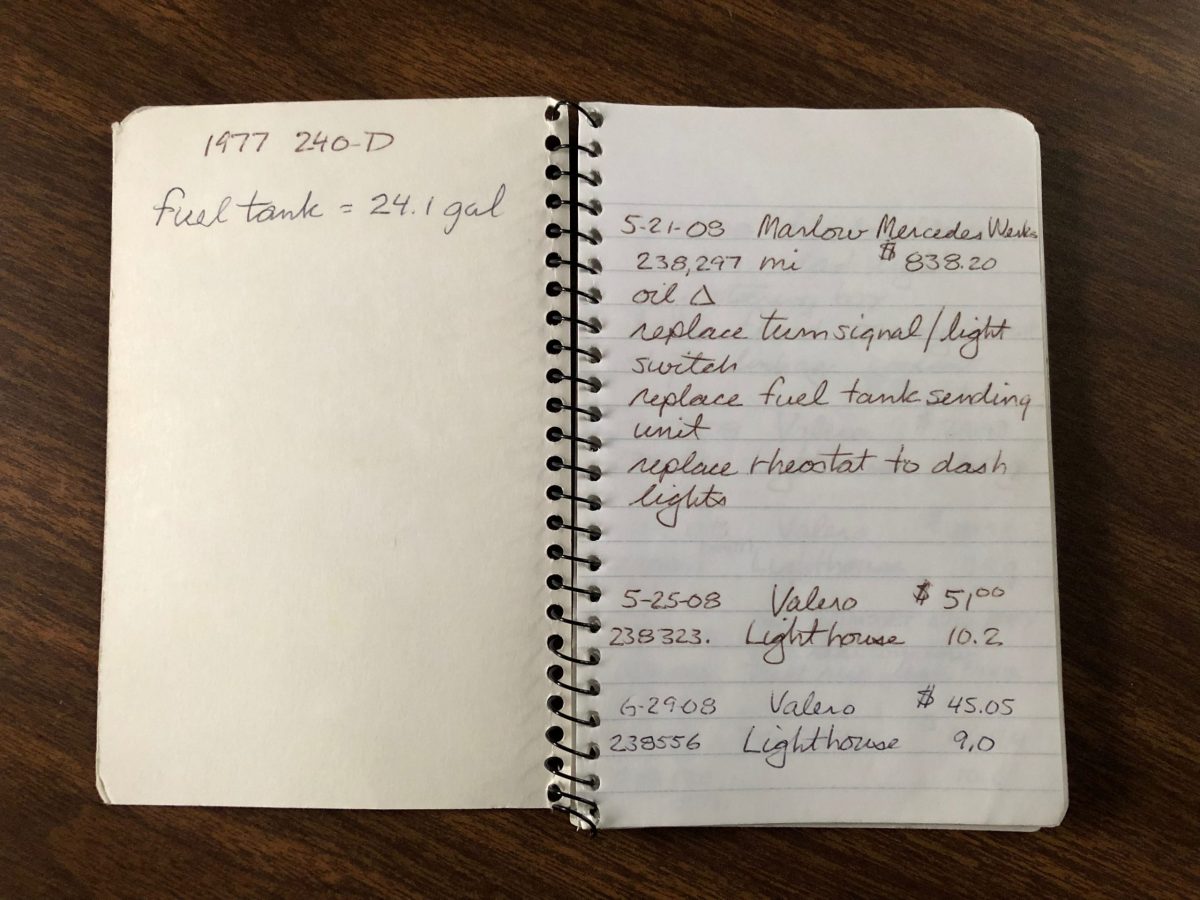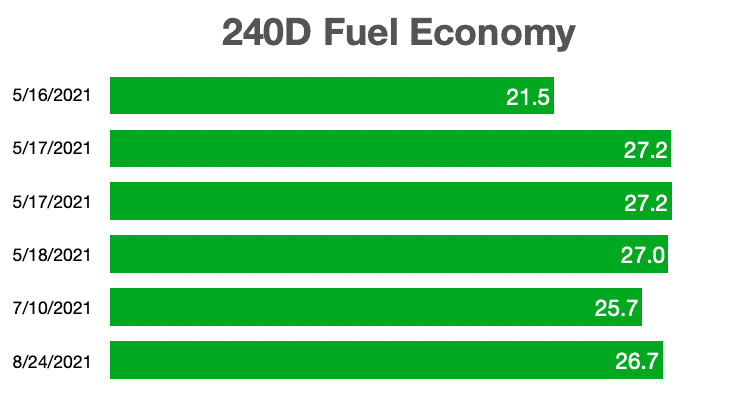240D Fuel Economy Update (Summer 2021)

It’s been a little more than three months and almost 2000 miles since I picked up the Colorado Beige 240D from its original owner in California, so I thought it might be time for a fuel economy update. In that time, I’ve driven the car from Monterey to Seattle, taken it in for a 250,000-mile service, and done various day trips around the area, including an overnight jaunt to Port Townsend.
Fortunately, keeping track of the 240’s fuel economy is easy because its prior owner kept meticulous records, including a handwritten fuel and maintenance log that documents each fill-up and service visit for the car since new. This spans four and a half small spiral notebooks (like the one picture above), each around 60 pages.
Going through the records, I found that the car’s last fill-up before my ownership was way back in August of 2018, when the car had 250,841 miles. In the following years, it was driven just a handful of times around town or for service visits — in total about 250 city miles, to which I also added a few dozen driving around Monterey before heading home to Seattle. For this period, the 240D returned an average of 21.5 miles per gallon.
Once I hit the freeway back to Seattle, the 240D’s fuel economy climbed to an impressive 27.1 mpg average over the next 900 miles and three fill-ups. That includes a number of mountain passes, which I took flat out in third gear. Not bad for a 45-year-old car. Then again, it does have only 62 horsepower.


On the way home, I stopped at Sequential Biofuels in Eugene, Oregon, to fill up the 240D with “B99” biodiesel (99.9% biodiesel). Why biodiesel? There are a number of compelling reasons. For one, biodiesel, which is typically made from vegetable oil or waste oil, is a carbon-neutral fuel. In other words, the creation of the fuel (e.g. growing crops) absorbs about the same amount of carbon dioxide from the atmosphere as is released when the fuel is burned. By comparison, petroleum diesel, which captured its CO2 way back in the Jurassic era, is a major carbon polluter.
Biodiesel also burns far cleaner than petroleum diesel. According to the U.S. Department of Energy (DOE), using biodiesel reduces harmful pollutants such as carbon monoxide and diesel particulates by almost 50% compared to petroleum diesel. The latter is quite evident when driving around — especially at night, when the headlights of other cars illuminate the diesel particulates coming out of the tailpipe. After filling up with biodiesel, they literally disappear.
Finally, biodiesel is better for the car. Back when the 240D was made, diesel fuel at the pump had a fair amount of sulfur in it. That helped to make the fuel more slippery, keeping intricate parts of the engine, such as its mechanical fuel injection system, properly lubricated. But sulfur is terrible for the environment, and the Environmental Protection Agency (EPA) has been steadily reducing the amount of sulfur in petroleum diesel over the last few decades. That’s great for the air we breathe but not so great for older diesel engines, which have to cope with harsher fuel. Biodiesel, though, has much greater lubricity than today’s ultra-low sulfur petroleum diesel (ULSD), negating these effects. It also has a higher cetane rating, meaning that it burns more evenly and completely than petroleum diesel, which in turn creates smoother and quieter operation.
For me, being able to use a clean and renewable source of energy — especially one that’s better for the car — is one of the great benefits of driving one of these old diesel Benzes.

There are a few negatives to using biodiesel, though. One is that it can be pretty tough to find. Fortunately, in Seattle we have a great source: Dr. Dan’s Biodiesel station (pictured above), located in the Ballard neighborhood. Dr. Dan’s has been in operation for over 20 years, is locally-owned, and uses primarily locally-sourced ingredients for the fuel, many of them waste products. And if you’re lucky, you may even catch Dr. Dan himself at the pump, like I did the last time I paid a visit.
Biodiesel is also generally more expensive than petroleum diesel. For instance, last time I filled up at Dr. Dan’s it cost me $4.79 per gallon, while the local Chevron is selling petroleum diesel for about a dollar a gallon less. For me, this isn’t much of an issue because I typically only drive a few hundred miles per month. But for someone who drives a lot more, it would definitely add up.
Another negative biodiesel side effect can be clogged fuel filters and weeping fuel hoses. Because biodiesel is a solvent, it can dissolve deposits in the fuel system, which then get trapped in the fuel filters, causing them to become restricted. It can also eat up old rubber hoses, which weren’t designed with biofuels in mind. Most modern fuel lines are tolerant of biofuels, though, so as long as you change your fuel filters and hoses in a timely manner, this shouldn’t be an issue. I’ve personally never had any of these issues with my cars.
Next Post: New Wheels, Same Look: Fitting Aluminum “Steelies” to the 240D